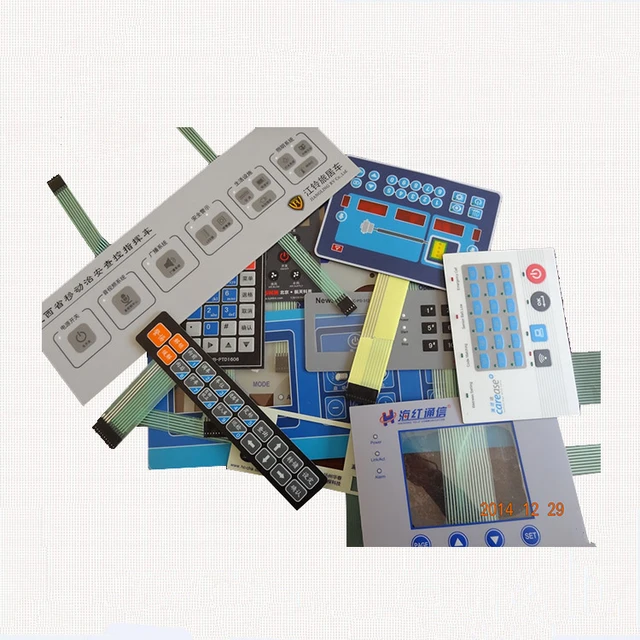Membrane Switch: A Comprehensive Guide to Its Uses and Applications
Membrane Switch: A Comprehensive Guide to Its Uses and Applications
Blog Article
Understanding Membrane Switches: The Secret to Reputable and long lasting Controls

What Are Membrane Buttons?
Membrane layer buttons are a sophisticated service in the realm of interface technology, integrating functionality and layout flawlessly. These gadgets offer as an interface in between users and electronic systems, integrating numerous components into a portable format. Normally built from flexible, thin layers of products, membrane layer switches are developed to reply to touch, allowing users to engage with equipment and digital gadgets effectively.
The key components of a membrane button consist of a published circuit layer, visuals overlay, and a spacer layer that stops unintentional activation. The graphic overlay can be personalized to show brand name identification or individual preferences, enhancing appearances while ensuring functionality. Membrane layer switches are frequently made use of in numerous applications, consisting of clinical gadgets, consumer electronics, and industrial equipment, owing to their toughness and resistance to environmental variables such as moisture and dirt.
Among the crucial benefits of membrane layer buttons is their capacity to withstand deterioration, making them ideal for high-traffic atmospheres. Furthermore, they are light-weight and call for marginal area, enabling for innovative styles in product advancement. On the whole, membrane changes represent a useful and efficient choice for contemporary digital interfaces, marrying modern technology with user-centric design principles.
Exactly How Membrane Layer Switches Over Work
The procedure of membrane layer switches over joints on an easy yet efficient system that converts user input into digital signals. These switches contain multiple layers, typically consisting of a visuals overlay, a spacer layer, and a circuit layer. When a user presses the button, the leading layer deforms, permitting a conductive aspect in the circuit layer to reach a corresponding conductive pad on the bottom of the visuals overlay. This get in touch with closes the circuit and sends out a digital signal to the device, suggesting that the button has actually been activated.
The style of membrane layer switches can vary, however they commonly include domes or tactile components to give responses to the individual, boosting the overall experience - membrane switch. The materials utilized in membrane switches, such as polyester or polycarbonate, add to their durability and resistance to ecological variables, consisting of dampness and dirt. Additionally, the published circuits are generally encapsulated, which protects them from deterioration with time.
Advantages of Membrane Layer Buttons

Furthermore, membrane layer switches are understood for their durability. Built from robust materials, they are immune to dirt, dampness, and physical wear, which significantly prolongs their life expectancy contrasted to standard mechanical switches. This durability makes them particularly suitable for high-traffic environments and applications calling for durability.
One more substantial benefit is the simplicity of cleansing and maintenance. The smooth surface of membrane switches over minimizes dirt build-up and is frequently resistant to spills, making them suitable for setups that require frequent sanitization.
Additionally, membrane layer switches supply a structured profile, resulting in a thinner style that can be incorporated into various tools without adding mass. This attribute not only improves the aesthetic appeal however additionally contributes to an extra ergonomic item design.
Applications of Membrane Layer Switches
User-friendly and flexible, membrane layer buttons find applications throughout a large array of industries, consisting of medical devices, consumer electronic devices, and industrial devices. In the clinical field, these buttons are integral to tools such as diagnostic equipment, person monitoring systems, and mixture pumps, where dependability and convenience of cleansing are critical. Their capacity to preserve and stand up to extreme environments functionality makes them optimal for such applications.

In consumer electronics, membrane buttons are used in items like microwaves, cleaning makers, and remote controls - membrane switch. Their streamlined layout enables instinctive interface, enhancing the overall user experience while supplying resilience and resistance to use and tear
Industrial devices additionally gains from membrane switches, particularly in control panels for equipment and automation systems. These switches provide security versus dust and moisture, making sure consistent efficiency in difficult environments. Additionally, their personalized attributes allow manufacturers to customize them to certain functional requirements, boosting effectiveness and functionality.
Picking the Right Membrane Layer Switch Over
When choosing a membrane switch, it is necessary to think about numerous elements that affect performance and suitability for Learn More certain applications. The main considerations include environmental problems, responsive feedback, toughness, and style requirements.
First, analyze the operating environment; switches revealed to dampness, chemicals, or severe temperatures call for specific products to make sure long life and performance. Next off, evaluate the requirement for tactile feedback. Depending upon customer communication, some applications might gain from a tactile action to confirm activation, while others might like a non-tactile layout for visual reasons.
Resilience is an additional vital variable; membrane layer switches should be developed to stand up to regular usage, effects, and abrasion. Make sure the picked button can sustain the expected lifecycle, specifically in high-usage situations.

Final Thought
In verdict, membrane layer changes offer as vital parts in the style of reliable and long lasting control systems throughout various industries. The convenience of membrane layer switches enables for customized remedies that meet details functional demands, reinforcing their value in contemporary technology.
Membrane layer switches over represent an important element of modern-day interface design, mixing performance with strength in numerous applications.Membrane switches are a sophisticated remedy in the world of individual interface technology, incorporating capability and style perfectly. Normally created from adaptable, slim layers of products, membrane layer buttons are made to react to touch, making it possible for customers to communicate with equipment and electronic tools effectively.
The style of membrane layer switches can differ, but they typically include domes or responsive aspects to supply comments to the customer, enhancing the overall experience.In conclusion, membrane switches over offer as vital components in the design my review here of durable and trusted control systems throughout numerous sectors.
Report this page